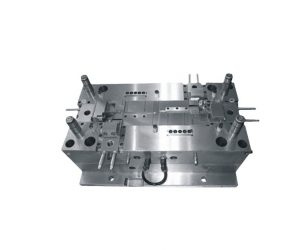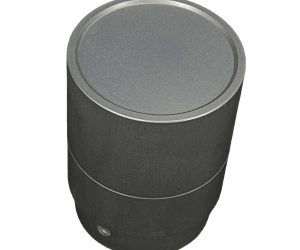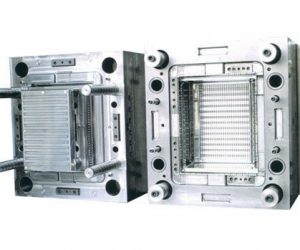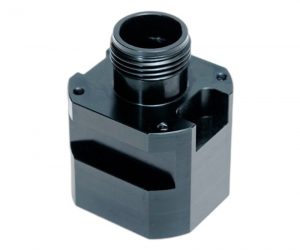Micromolding, a pinnacle of precision engineering, transcends mere miniaturization; it's the art of sculpting functionality at the micron scale. This article delves into the intricacies of this specialized manufacturing technology, exploring its underlying principles, inherent advantages, diverse applications, and the formidable challenges it presents. We will also provide guidance on selecting a competent micromolding partner, a crucial step in ensuring project success within this demanding field.
The fundamental principles of micromolding revolve around the injection of thermoplastic materials into exquisitely crafted molds – cavities so minute that their dimensions are measured in microns. This process necessitates specialized equipment capable of handling the extreme precision and minute tolerances demanded by this technology. The resulting parts, solidified after cooling, exhibit geometries and dimensional accuracy unattainable through traditional manufacturing processes. This capability opens doors to a plethora of high-tech applications, including, but not limited to, biomedical devices, microelectronics, and optical systems.
The advantages of micromolding are multifaceted and compelling. Its capacity to produce parts with intricate geometries and minuscule dimensions, far exceeding the capabilities of conventional methods, is paramount. Furthermore, micromolding facilitates high-volume production, thereby achieving economies of scale and reducing per-unit costs. The inherent automation of the process minimizes human error, enhancing efficiency and consistency. Finally, the resulting components often exhibit superior material properties, boasting enhanced strength, wear resistance, and corrosion resistance.
The applications of micromolding span a vast industrial landscape. In the biomedical sector, it enables the creation of sophisticated miniature devices, from pacemakers to intricate microfluidic systems. The electronics industry leverages micromolding for the production of microconnectors, sensors, and other components integral to modern electronics. Automotive and aerospace applications range from high-performance engine components to lightweight, high-strength structural elements. The versatility of micromolding extends to numerous other sectors, constantly pushing the boundaries of miniaturization and functionality.
However, the path to successful micromolding is not without its obstacles. The highly specialized nature of the technology demands a skilled workforce, making talent acquisition a significant hurdle. The substantial capital investment required for equipment and infrastructure can pose a barrier to entry, particularly for smaller enterprises. Furthermore, the intricate supply chain management necessitated by the automated nature of the process demands meticulous planning and execution. Finally, maintaining a competitive edge in this rapidly evolving field necessitates continuous innovation and adaptation to technological advancements. The future of micromolding hinges on addressing these challenges effectively. Choosing a partner with proven expertise, a robust infrastructure, and a commitment to innovation is paramount to navigating the complexities of this transformative technology.
What is Micro Molding?
Micro molding is a method of shaping and forming thermoplastics to create products, pieces, and components that are often less than a gram in weight and just a few millimeters in diameter or size. However, it’s more than size that defines the components. Micro molding also requires high precision, accuracy, and consistency in producing complex geometries and features with micron tolerances.
Micro molding is not a single process, but a group of processes that use different mechanisms to replicate the master pattern on a mold to a plastic material. Some of the common micro molding processes are:
- Micro injection molding: A process that uses an injection unit to inject molten plastic into a mold cavity under high pressure and speed. The mold cavity has a shape that matches the desired part. The plastic cools and solidifies in the mold, forming the part. The part is then ejected from the mold.
- Micro compression molding: A process that uses a hydraulic press to compress a preheated plastic material into a mold cavity under high pressure. The mold cavity has a shape that matches the desired part. The plastic cools and solidifies in the mold, forming the part. The part is then removed from the mold.
- Micro casting: A process that uses a vacuum or centrifugal force to fill a mold cavity with molten plastic. The mold cavity has a shape that matches the desired part. The plastic cools and solidifies in the mold, forming the part. The part is then separated from the mold.
- Micro intrusion: A process that uses an extruder to push molten plastic through a nozzle into a mold cavity under high pressure. The mold cavity has a shape that matches the desired part. The plastic cools and solidifies in the mold, forming the part. The part is then cut from the nozzle.
How Does Micro Molding Work?
The micro molding process starts in a tooling department where a mold is created that has a cavity in the shape of the part desired. The mold is usually made of steel or aluminum and has very fine details and features. The mold is also designed to minimize shrinkage, warpage, and other defects that may affect the quality of the part.
The next step is to prepare the plastic material for molding. Depending on the type of micro molding process, the plastic material can be in different forms, such as pellets, granules, powder, or liquid. The plastic material is heated and melted until it reaches a suitable viscosity and temperature for molding.
The melted plastic material is then transferred to the micro molding machine, where it is injected, compressed, casted, or intruded into the mold cavity under controlled conditions of pressure, speed, time, and temperature. The plastic material fills the mold cavity and conforms to its shape.
The plastic material then cools and solidifies in the mold, forming the part. The cooling time depends on several factors, such as the thickness, size, shape, and material of the part. The cooling time is critical for ensuring dimensional accuracy and stability of the part.
The final step is to eject or remove the part from the mold. Depending on the type of micro molding process, different methods can be used to separate the part from the mold, such as pins, air blasts, vacuum suction, or manual extraction. The part may also need to be trimmed or degated to remove any excess material or flash.
The micro molded part is then inspected for quality and functionality using various techniques, such as visual inspection, microscopy, metrology, or testing. The part may also need to be cleaned or sterilized before packaging or assembly.
What are the Benefits of Micro Molding?
Micro molding offers several benefits for producing small and precise plastic parts and components, such as:
- High precision and accuracy: Micro molding can produce parts with complex geometries and features with micron tolerances, which are difficult or impossible to achieve with other manufacturing methods. Micro molding can also ensure consistency and repeatability in producing parts with the same specifications and quality.
- Reduced material waste and cost: Micro molding can use less material to produce parts, as the parts are smaller and lighter. This can reduce material waste and cost, as well as environmental impact. Micro molding can also eliminate or reduce the need for secondary operations, such as machining or finishing, which can further save time and money.
- Enhanced performance and functionality: Micro molding can create parts with improved mechanical, electrical, optical, or biological properties, depending on the type and grade of plastic material used. Micro molding can also enable the integration of multiple functions or components into a single part, which can simplify the design and assembly process and enhance the performance and functionality of the part.
- Increased design flexibility and innovation: Micro molding can allow for more design flexibility and innovation, as it can create parts with intricate shapes, patterns, textures, or colors that are not possible with other manufacturing methods. Micro molding can also enable the development of new products or applications that require small and precise plastic parts and components.
What are the Applications of Micro Molding?
Micro molding has a wide range of applications in various industries that require small and precise plastic parts and components, such as:
- Medical: Micro molding is widely used in the medical industry to produce parts for devices, implants, diagnostics, drug delivery, surgery, or biotechnology. Some examples of micro molded medical parts are catheters, stents, valves, needles, sensors, microfluidic chips, or bioresorbable implants.
- Electronics: Micro molding is also used in the electronics industry to produce parts for devices, circuits, connectors, switches, or sensors. Some examples of micro molded electronic parts are microchips, microspeakers, microphones, antennas, or lenses.
- Automotive: Micro molding is used in the automotive industry to produce parts for systems, components, or sensors. Some examples of micro molded automotive parts are fuel injectors, airbag initiators, pressure sensors, or optical sensors.
- Aerospace: Micro molding is used in the aerospace industry to produce parts for systems, components, or sensors. Some examples of micro molded aerospace parts are gyroscopes, accelerometers, actuators, or optical fibers.
- Consumer: Micro molding is used in the consumer industry to produce parts for products, devices, or accessories. Some examples of micro molded consumer parts are watches, hearing aids, cosmetics, or jewelry.
What are the Challenges of Micro Molding?
Micro molding is a process that involves creating very small plastic parts or components with complex features and high precision. Micro molding can be used for various applications, such as medical devices, microelectronics, aerospace, and biotechnology. However, micro molding also poses some challenges that need to be overcome to ensure the quality and functionality of the final products. Some of these challenges are:
- Material selection: Choosing the right material for micro molding is crucial, as it affects the properties, performance, and durability of the micro parts. The material should have good flowability, dimensional stability, and resistance to heat, chemicals, and wear. Moreover, the material should be compatible with the molding process and the intended use of the product. For example, some materials may require special additives or treatments to enhance their moldability or biocompatibility.
- Mold design: Designing a mold for micro molding is a complex and delicate task, as it requires high accuracy and precision. The mold should have fine details, tight tolerances, and smooth surfaces to produce micro parts with intricate geometries and features. The mold should also have adequate venting, cooling, and ejection systems to prevent defects such as flash, sink marks, warping, and sticking. Additionally, the mold should be made of durable and wear-resistant materials to withstand the high pressure and temperature of the molding process.
- Process control: Controlling the process parameters for micro molding is essential, as they affect the quality and consistency of the micro parts. The process parameters include temperature, pressure, injection speed, cycle time, and clamping force. These parameters should be carefully calibrated and monitored to ensure optimal flow, filling, packing, cooling, and curing of the material. Any variation or deviation in the process parameters can result in defects such as short shots, burn marks, bubbles, voids, and dimensional inaccuracies.
- Inspection and testing: Inspecting and testing the micro parts for micro molding is a challenging and time-consuming task, as it requires sophisticated equipment and methods. The inspection and testing should be able to detect any defects or deviations in the shape, size, surface finish, functionality, and performance of the micro parts. The inspection and testing methods may include optical microscopy, scanning electron microscopy (SEM), X-ray computed tomography (CT), laser scanning confocal microscopy (LSCM), coordinate measuring machine (CMM), tensile testing, fatigue testing, and biocompatibility testing.
How to Choose a Micro Molding Partner?
Micro molding is a process that produces extremely small and complex plastic parts for various applications, such as medical devices, electronics, aerospace and more. Micro molding requires a high level of precision, accuracy and quality control to ensure the parts meet the specifications and standards of the customers. Choosing a micro molding partner is an important decision that can affect the success of your project and the performance of your product. Here are some factors to consider when looking for a micro molding partner:
- Experience and expertise: You want to work with a micro molding partner that has extensive experience and expertise in micro molding, especially in your industry and application. A micro molding partner that has a proven track record of delivering high-quality micro molded parts can help you avoid costly mistakes and delays. You should also look for a micro molding partner that has the necessary certifications and accreditations to ensure compliance with the relevant regulations and standards.
- Capabilities and equipment: You want to work with a micro molding partner that has the capabilities and equipment to handle your project from design to delivery. A micro molding partner that offers a full range of services, such as design assistance, prototyping, tooling, production, inspection and testing, can help you save time and money by streamlining the process. You should also look for a micro molding partner that has the latest technology and equipment to ensure the highest level of precision and quality.
- Communication and collaboration: You want to work with a micro molding partner that communicates and collaborates with you throughout the project. A micro molding partner that listens to your needs and expectations, provides feedback and suggestions, and keeps you updated on the progress and status of your project can help you achieve your goals and ensure your satisfaction. You should also look for a micro molding partner that is flexible and responsive to your changing requirements and challenges.
- Cost and delivery: You want to work with a micro molding partner that offers competitive pricing and timely delivery. A micro molding partner that provides transparent and accurate quotes, adheres to the agreed budget and timeline, and delivers high-quality micro molded parts on time can help you optimize your return on investment and meet your deadlines. You should also look for a micro molding partner that has a reliable supply chain and logistics network to ensure smooth and efficient delivery.




